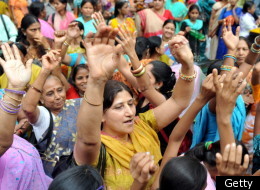 |
| Phipps Conservatory |
Wednesday, September 5, 2012
Thoughts from Gita Class, September 4, 2012
Thursday, June 28, 2012
Catholicism and Hinduism are similar, but not in the ways that one author thinks
Monday, May 14, 2012
Music and God
I am sitting here, at home, at night, listening to one of Chopin's Nocturnes. And I think that I am listening to God. And at the same time, God is listening to the music. I am Brahman, listening to Brahman play Brahman.
I also think, that with some exceptions, there is not spiritual music and secular music. There is only music. God can be found in any piece (again, with exception, I guess.)
Monday, March 19, 2012
Jimmy Carter shares his ideas about the Bible in a new book
An excerpt from the interview:
The example that I set in my private life is to emulate what Christ did as he faced people who were despised like the lepers or the Samaritans. He reached out to them, he reached out to poor people, he reached out to people that were not Jews and treated them equally. The more despised and the more in need they were, the more he emphasized that we should go to and share with them our talent our ability, our wealth, our influence. Those are the things that guide my life and when I find a verse in the Bible that contradicts those things that I just described to you, I put into practice the things that I derive from my faith in Christ.
President Jimmy Carter Authors New Bible Book, Answers Hard Biblical Questions
Thursday, March 15, 2012
Yes. After thousands of years. Somebody is writing a sequel to the Ramayana.
I'm a lazy writer. Many of my writig projects appropriated a myth or a previously published work in the public domain like "A Christmas Carol." I'd like to think that I'm fond of such works. But I also realize that I'm attracted to it because I'm lazy. To me, it's so much easier to write something with existing characters than to make them up from scratch.
For years, I've been trying to write a modern take on the Greek myths, specifically the binding and escape of Prometheus. It started as an attempt to be witty. I thought, aren't the Greek gods and goddesses essentially a crime family? And Zeus the original god-father?
Well, there have been many iterations. Many. And most no longer than a chapter.
Well, I'm knee deep into Hinduism now. And one deity I have consistently called on to bring me closer to God has been Hanuman. So it follows suit that I am fond of the Ramayana. So a little while back, I thought, instead of appropriating Greek myth, why not appropriate this great Hindu work. I wouldn't be the first, or course. Not even the first westerner. But it still sounded like something fun to do. And it would also give me the opportunity to deal with such wonderful aspects as Hanuman's love and duty toward Rama.
But one thing I want to do was alter a bit so that there were a new, young character in the middle of it. Someone less than perfect who interacts with Hanuman and Ram. Someone the reader can identify with. And if it is to be a YA story, having a young protagonists is pretty much a necessity.
But as I thought a bit more, I had the idea to give myself some freedom by using the existing characters, but making the plot my own. A Percy and the Olympians version of the Ramayana. And one way I figured I could do that was to make it a sequel. And not only that, maybe use my spiritual bio as inspiration. That is, show the citizens of Rama's kingdom becoming disenchanted with him, abandon him, then search for him again.
Course, to be honest, I've been at this writing game for so long. I have such a low opinion of my talent. Plus I think I've just become so bored with it. But if I try to remember that I am not the doer, and never have been, maybe I stand a chance. If it is Mother, Thakur, Rama or Hanuman that wants me to write this, they will be the ones wrting it. So I really have nothing to worry.
Another key is that I make it a unabashed labor of love. Write not for glory, money, or to impress anybody. But to write to emphasize the aforementioned qualities of love and loyalty. To make it a puja to Hanuman and Rama. To tap my devotion at it's root and put it down on paper.
And if this doesn't go anywhere, I'll really be no worse off than I am now.
Wednesday, February 15, 2012
CNN Heroes nominee dedicated to feeding the poor
Saturday, April 2, 2011
Modernity, Memory and Mantra

Went to my first ashram last weekend, a Ramakrishn
Anyway, I found this article on the Huffpost that talks about the practice of memorizing and chanting the Bhagavad Gita:
Mantrajapa (chanting of mantra) simultaneously engages three of the eight limbs of Yoga -- namely pranayama (breath control), dharana (concentration) and dhyana (devotion or meditation on the Divine). It has also been referred to as the Yoga of Sound, with scientific studies enumerating its medical benefits, which include lowering blood pressure to producing endorphins and supporting healthy metabolism. But science is not what is on our minds when we lose ourselves in the power and beauty of the Gita. Perhaps it is the knowledge that these are the words of Lord Krishna. Or maybe there is spiritual power in the intonations and rhythmic patterns in which the Gita is traditionally chanted. Could it be the recognition that we are connecting to millions now and before us who have indulged in this primeval spiritual practice? Whatever the reason, my family is experiencing something deeply moving and profound.
